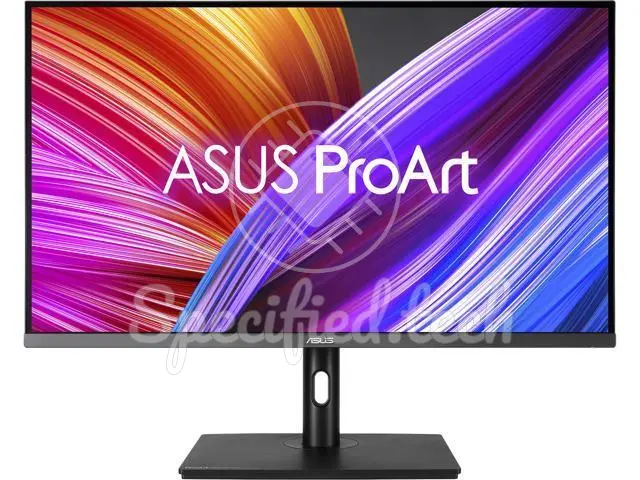
Today we will look at the monitor PA32UCR from Asus from the year 2021. Within this article, we will first take a closer look at the most important feature of a monitor -the display-, then the design, and in the next section we will go into the features of the monitor. Of course, power consumption, certifications, connectivity and other important details will also be considered.
Display
Let's start with the size of the actual display. This is given in inches and measures the screen diagonal of the display. The monitor PA32UCR has a display size of 31 inches ( 81.2 cm on the diagonal). It should be noted, however, that displays in this category can have different dimensions, since square monitors, for example, can have the same diagonal as a widescreen monitor. The size specification of a monitor refers to the screen diagonal, which is usually specified in inches. It is only comparable to a limited extent for different formats. For example, a conventional 4:3 monitor with the same screen diagonal has 6% less width, but 13% more height and a total of 7% more surface area than a monitor in 16:10 format. Despite the difference in working area, wider monitors are better suited for consuming games or current movies, for example. It is also easier to display several documents simultaneously on widescreen monitors. So, it depends on the current use case whether the aspect ratio of 1.778 : 116 makes sense for the intended use case. Approximately 91.2 % of the front of the monitor is taken up by the display, while the remaining area consists of screen edges that cannot display any image information. If you want to set up several monitors next to each other, it is advisable to choose monitors with narrow edges. The display is a AHVA IPS panel. The panel has a resolution of 3840 x 2160 px. The pixel density is 137 ppi. The pixel pitch is 0.185 mm. The continuous possible brightness specified by the manufacturer Asus is 400 nt. The monitor's panel is characterized by its luminosity of 1000 nt. The panel is illuminated by Mini LED. The built-in panel ensures stable color reproduction of the image, even at deviating viewing angles, by means of its 178 ° (horizontal) viewing angle. Asus promises stable color reproduction moreover within a 178 ° vertical angle. The refresh rate is horizontally seen at the PA32UCR 40 khz to 144 khz. Vertically, however, the image renews at a minimum rate of 30 hz up to 60 hz. The minimum response time of the monitor is ms. The display panel is Anti-glare/Matte (3H).
Color representation
The panel has a bit depth of 10 per color channel, but what does that mean? The number of bits determines how many colors can be encoded for the individual pixels of the display. For an 8-bit panel, for example, this is 256 different colors (2^8 = 256). However, since we usually display three different colors per pixel at the same time, in theory about 16 million (256^3) different colors are possible by mixing the three pixels. A 10-bit panel could even display a billion colors. The coverage of the Adobe RGB 1998 color space is 99 % according to the manufacturer. According to the manufacturer, the coverage of the DCI-P3 color space is 99 %. According to the manufacturer, the coverage of the SRGB color space is 100 %. The REC 2020 color space is covered to 87 %.
Contrast ratio
Contrast ratio is a common measurement used to represent the maximum relative differences in brightness between black and white. It describes the ability of a screen or projector to produce a high-contrast image and is the quotient of the maximum and minimum displayable luminance. The higher the values are away from each other, the stronger the quantitatively seen difference between black and white is set up, which in turn results in an improved image quality. This monitor from Asus has a static contrast ratio of 1000 : 1 , according to the manufacturer. In contrast to the static contrast ratio, the dynamic contrast ratio changes the brightness of the panel itself in addition to the difference measurement from black to white. In addition to the difference between the brightest and the darkest pixel, the backlight is thus changed. Since the brightness of the panel may not be able to be adjusted exactly to a single pixel, a so-called halo effect is possible. The value of 100000000 : 1 of dynamic contrast ratio for the monitor PA32UCR cannot provide any information about the severity of the halo effect here. Therefore, it is more useful to compare the static contrast ratio.
HDR
The monitor supports all HDR modes listed here:
- HDR 10
- HDR 1000
- HDR HLG
screen design
Further information
- 1.2
- 2.0

